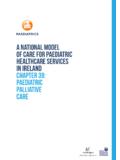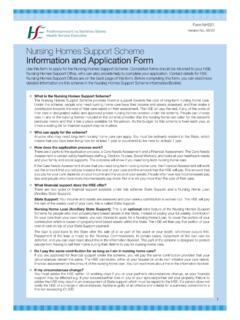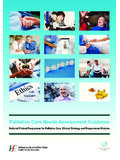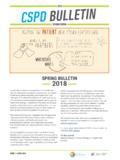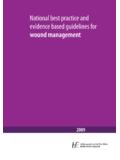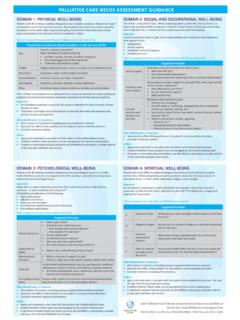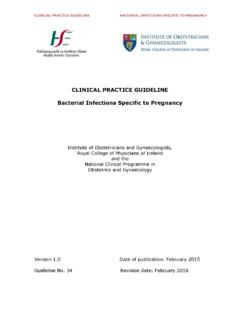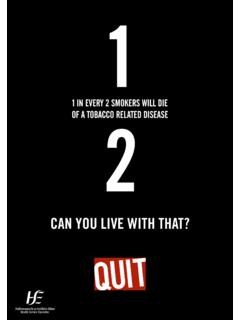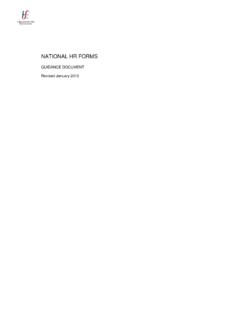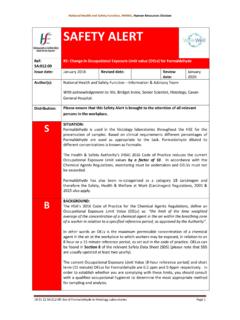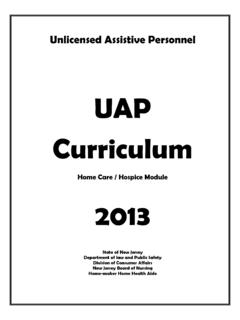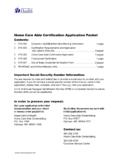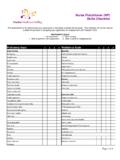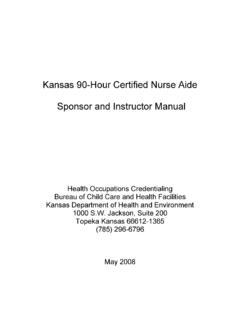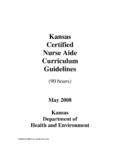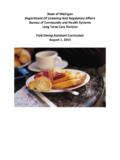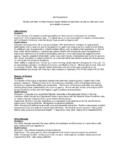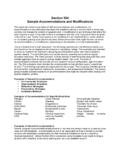Transcription of Child Protection and Welfare Practice Handbook
1 Child Protection and Welfare Practice HandbookHealth Service ExecutiveChild Protection and Welfare Practice HandbookOak House Dr Steevens HospitalMillennium Park Steevens LaneNaas Dublin 8Co. KildareTel: (045) 880400 Tel: (01) 635 Health Service Executive 2011 Equalities StatementThroughout the process of ensuring the safety and Welfare of a Child , professionals should be aware of differing family patterns and lifestyles, not only due to different racial, ethnic and cultural groups but also issues of age, disability, gender, religion, language and sexual orientation. DisclaimerThe Practice Handbook is not and cannot be a comprehensive procedure for Child Protection and Welfare Practice . It is a quick reference document to support skilled Practice both within the HSE and between it and partner agencies. It is not a complete or authoritative statement of the law and is not a legal interpretation.
2 Professionals will need to be familiar with Children First: National Guidance for the Protection and Welfare of Children (2011), together with other relevant law, policy, procedures and guidelines that govern their Messages from research , Ireland: Serious Case Inquiries Recommendations along with the Practice Notes included in the Practice Handbook are, unless otherwise indicated, mainly interpretations of key messages from longer complete documents to support Practice . For the more detailed issues raised by the source documents and a thorough understanding, readers should consult the original publications, listed in Section : References. A separate Bibliography of useful source material is available online at OR (North South Initiative on Child Protection Awareness, currently under development).ContentsForeword viiAcknowledgements ix1 Introduction to the Handbook How to use the Handbook Key principles of best Practice in Child Protection and Welfare Glossary of Terms Definitions of the four categories of Child abuse Definition of emotional abuse Definition of sexual abuse Definition of physical abuse Definition of neglect Child Neglect the most common type of abuse 142 Allied professionals and all others who work with children and their families Roles and Responsibilities in identifying and responding to Child Protection and Welfare concerns HSE staff Designated Liaison Persons Agencies and services outside the HSE (including voluntary and community sectors)
3 What constitutes reasonable grounds for a Child Protection or Welfare concern What to do if reasonable grounds for concern exist Questions that may help staff when they are concerned about a Child s Welfare Responding to a Child who discloses abuse suggested guidelines What to do if you are concerned about a Child s safety and/or Welfare Informal consultation Out-of-hours services/In case of an emergency How to make a formal referral to Children and Family Services Anonymous and malicious referrals Third-party referrals The position of parents What happens after a referral is made to Children and Family Services Feedback to Referrer Your role after making a referral to Children and Family Services What if you do not agree with the outcome of the referral to Children and Family Services Key Practice points in dealing with Child Protection and Welfare concerns 393 Social Work Procedures and Practice Child Protection and Welfare Process - Overview Referral Initial Assessment Further Assessment Child Welfare Child Protection Strategy Meeting Child Protection Conference Child Protection Plan Core Group Child Protection Notification System (CPNS)
4 Child Protection Review Conference Joint HSE/Garda action Communication and information sharing between agencies Family Welfare Conference Intra-familial and Extra-familial Mistreatment Retrospective Disclosures Risk factors in Child Protection Age of the Child Domestic and Sexual Violence Parental Mental Health Problems Parental Substance Misuse Parental Intellectual Disability Children with disabilities Unknown male partners and their history/ association with the family Families who are uncooperative or hard to engage Poverty and Social Exclusion Child Protection in a multicultural context Child Trafficking Forced Marriage Female Genital Mutilation So-called Honour-based Violence Best Practice for the use of interpreters Assessment Practice in Child Protection and Welfare Key matters to consider in assessments See life from the Child s point of view Attachment Carrying out home visits Links between Child abuse and cruelty to animals Assessing Parenting Capacity Working with fathers/male partners as part of the assessment Evaluating Child and family progress Supervising the assessment Record-keeping and file management Use of chronology as part of the assessment process Children in Care Private Foster Care Management of Serious Incidents Responding to a Child s death 121v4 Support and Guidance for Practitioners Supervision Personal safety questions and risk checklist for practitioners Continuous professional development Managing allegations against workers and volunteers Managing complaints Protected disclosure 1305 Resources National contacts for HSE Children and Family Services 132 References 137 Appendices 143
5 Appendix 1: Summary of Key Legislation 144 Appendix 2: checklist for multi-agency contribution 152 Appendix 3: Ireland: Serious Case Inquiries Recommendations for Practice 160 Appendix 4: Flowchart - Response when an infant under 12 months presents with injuries 164 Appendix 5: Child Development checklist : 0-5 years 165 Appendix 6: Parental issues that can impact on parenting capacity 171 Index 177viForeword Dear Colleague,Protecting children and promoting their Welfare is a collective activity and responsibility, and I am pleased to commend this Practice Handbook as an aide to delivering accountable, consistent and transparent Practice in protecting children in aspiration for children in Ireland is that they will fulfill their potential and be healthy in every aspect of their lives, physically and mentally. This vision can only be achieved with the cooperation of the relevant professions across departments, support services and vital work of social workers and other professionals together with partner agencies in assessing risk and acting to protect vulnerable children is difficult and demanding.
6 This Practice Handbook is designed as a quick reference book to help support front-line Practice . It sets out the key issues in the different stages of action from referral through assessment to intervention. It has taken account of the recommendations of inquiries and case reviews, together with international research and best Practice Handbook is designed to be a companion volume and to complement Children First: National Guidance for the Protection and Welfare of Children (2011), which is the full reference text for practitioners. It will also support policies, procedures and legislation. The Practice Handbook is a guide to basic and consistent Practice , but it cannot and does not cover everything. It will give clear guidance, but additional support and advice should be sought through your peers and your line Practice Handbook builds on the skills as well as the resilience and determination of agencies working together to put children first.
7 It is a professional guide to help us be reliable and dependable partners and to ask the same of others. I acknowledge to all those working directly with and within Social Work teams, those within the Court systems and those working in all agencies that social work is both demanding and complex. Remember, the population is not made up of customers to whom we sell or colleagues to whom we pander, but of partners on whom we can rely and with whom we can pay tribute to the dedication, hard work and commitment of the many front-line social workers and other professionals who are challenged on a daily basis to provide a quality service. They deserve the respect and support of the communities whom we serve. They should not be hindered from making the best intervention possible for children and families. The task for all of us who are dedicated to making Ireland safer for children is to use our professional skills, work together and offer an accountable, consistent and transparent Child -centred service to protect JeyesNational Director, Children and Family ServicesHealth Service ExecutiveSeptember 2011 Acknowledgements The development of this Practice Handbook was aided greatly by a dedicated group of HSE Children and Family Services practitioners, front-line managers and senior staff who provided critical feedback throughout the process.
8 In all cases this meant additional work, time and travel. Their contributions ranged from providing content, through commenting on drafts, to helping think through layout and structure. Their observations and input have been crucial in producing a document that is based on experience, best Practice and research findings. The national office of the HSE Children and Family Services commissioned The Potential Organisation to develop the Child Protection and Welfare Practice Handbook . Particular thanks are due to Paul Clark, Ane Auret and Paul Wedgbury. A Reference Group of Children and Family Services personnel edited and coordinated the publication and consisted of the following people: Linda Creamer Olivia O ConnellBoyd Dodds Claire O KellyPhil Garland Karen O MahoneyMarie Kennedy Charney WeitzmanCon Lynch In addition, key personnel across the wider Children and Family Services group have made significant contributions.
9 All staff who have assisted in the development of this Practice Handbook deserve both our highest praise and considerable , thanks are also due to Carole Devaney for proofing and indexing the Practice Handbook , to Penhouse Design for graphic design and layout, and to Brunswick Press for printing the to Practice Handbook How to use the Practice Handbook Key principles of best Practice in Child Protection and Welfare Glossary of Terms Definitions of the four categories of Child abuse Definition of emotional abuse Definition of sexual abuse Definition of physical abuse Definition of neglect Child Neglect the most common type of abuse 1412 Child Protection and Welfare Practice How to use the Practice Handbook Section 1: For everybody whose work brings them into direct or indirect contact with children and their families. It provides a Glossary of Terms frequently used in Child Protection and Welfare Practice , as well as the definitions of the four types of Child abuse.
10 There is a more detailed chapter on Child neglect since this is the most common type of Child abuse and is also the most reported concern to the HSE Children and Family 2: For all allied professionals and volunteers whose work brings them into direct or indirect contact with children and their families. It aims to provide advice and guidance on what to do if you are worried about a Child , your roles and responsibilities, how to refer your concerns and your involvement after you have made a referral to Children and Family Services. It also provides suggested guidelines on how to respond to a Child who discloses 3: For key Social Work staff of the HSE Children and Family Services. This section aims to provide a practical resource in identifying, assessing and responding to risk. It gives an overview of the Child Protection process, highlights known risk factors in Child Protection work and outlines key triggers to consider when carrying out 4: Provides more information around support and guidance for Social Work staff, including supervision, continuous professional development and training, managing allegations, complaints and how to make a protected 5: Resources include national contacts for the HSE Children and Family Services and a list of References used to inform the Practice Handbook .
